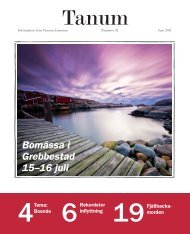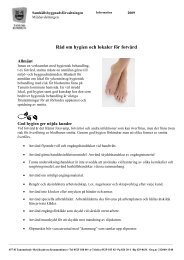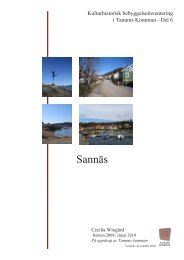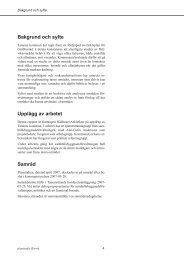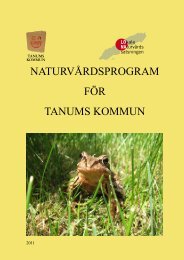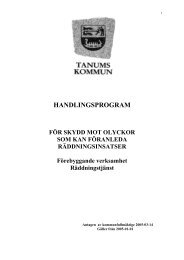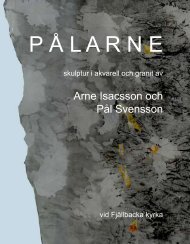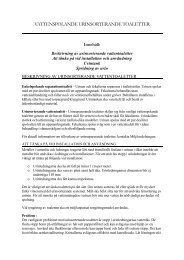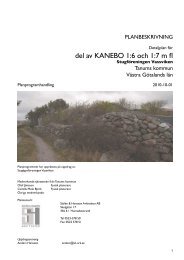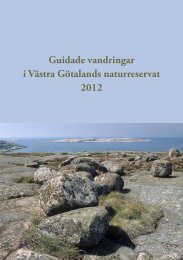Hedgehogs in rural landscapes
Hedgehogs in rural landscapes
Hedgehogs in rural landscapes
Create successful ePaper yourself
Turn your PDF publications into a flip-book with our unique Google optimized e-Paper software.
PrefaceIn northern Europe and Scand<strong>in</strong>avia only one species of hedgehogs is present, Er<strong>in</strong>aeceuseuropaeus. New evidence shows that although the species has a wide distribution range,populations are dim<strong>in</strong>ish<strong>in</strong>g <strong>in</strong> abundance and <strong>in</strong> some places becom<strong>in</strong>g locally ext<strong>in</strong>ct. Thereis no clear s<strong>in</strong>gle factor caus<strong>in</strong>g this pattern, but it appears to be a comb<strong>in</strong>ation of severalfactors. Food availability plays a major role <strong>in</strong> their distribution and behaviour, e g. <strong>in</strong> F<strong>in</strong>landthe home range of hedgehogs is larger than <strong>in</strong> Sweden or the UK. S<strong>in</strong>ce their ability todisperse is quite limited and that large numbers are killed by road traffic, there is a highisolation effect <strong>in</strong> the areas of low hedgehog population. The general change <strong>in</strong> <strong>rural</strong>landscape towards large-scale monocultures and less complexity, traffic mortality and agreater badger population are some of the causes that might <strong>in</strong>fluence the disappearance ofhedgehogs <strong>in</strong> <strong>rural</strong> areas.<strong>Hedgehogs</strong> were <strong>in</strong>cluded <strong>in</strong> the national red list <strong>in</strong> Sweden, but from the list <strong>in</strong> 2000. In UK,they are <strong>in</strong>cluded <strong>in</strong> the national Biodiversity Actions Plan. Here we present a summary of thelatest research results on the hedgehog’s ecology and status <strong>in</strong> Scand<strong>in</strong>avia and UK that waspresented at the workshop held at Nordens Ark <strong>in</strong> may 2011. Dur<strong>in</strong>g the workshop, we raiseda question: are we fac<strong>in</strong>g an ext<strong>in</strong>ction threat or just a tolerable dim<strong>in</strong>ish<strong>in</strong>g of the population?3
Us<strong>in</strong>g the web-based <strong>in</strong>quiry to estimate hedgehog abundance <strong>in</strong> the region of Fyrbodal,SwedenMattias Olsson and Ingvar OlofssonConcern has been raised about the status of the Hedgehog population <strong>in</strong> Sweden. Europeanstudies have revealed a high mortality rate with several underly<strong>in</strong>g factors, <strong>in</strong>clud<strong>in</strong>g trafficmortality, predation (badger, red fox, etc) and mortality dur<strong>in</strong>g hibernation. However, the lackof recent Swedish studies makes it impossible to estimate the population status and spatialdistribution for hedgehogs <strong>in</strong> Sweden. The aim of this study was to get a first and prelim<strong>in</strong>aryoverview of the abundance and spatial distribution of hedgehogs <strong>in</strong> the region of Fyrbodal (14municipalities) <strong>in</strong> Southwestern Sweden. A web-based platform was used to collect publicsight<strong>in</strong>gs dur<strong>in</strong>g 2010, and the respondents could also report historical sight<strong>in</strong>gs <strong>in</strong> theformula. Respondents were asked to report several factors related to each sight<strong>in</strong>g, <strong>in</strong>clud<strong>in</strong>gdate, location, reproduction and habitat features where the hedgehog was observed. Thepublic was <strong>in</strong>formed about the project and how to answer the enquiry by local and regionalmedia (newspapers, TV and radio), through NGOs and the municipalities web-pages.In total 641 reports of hedgehog occurrence (yes/no) were registered dur<strong>in</strong>g 2010, and 570 ofthose were positive reports of hedgehog sight<strong>in</strong>gs. With<strong>in</strong> those 570 reports, 652 <strong>in</strong>dividualhedgehogs were reported. 87 % of the reports were from the 4 major cities with<strong>in</strong> the studyarea; Trollhättan, Vänersborg, Uddevalla and Åmål. Only few and scattered reports were fromsmaller cities such as Strömstad, D<strong>in</strong>gle, Hällevadsholm, Smögen, Fjällbacka, Ljungskile andGrebbestad. 511 reports conta<strong>in</strong>ed detailed <strong>in</strong>formation about location, of these 7% (37) wereobservations from <strong>rural</strong> areas, outside cities or villages.The public <strong>in</strong>volvement <strong>in</strong> report<strong>in</strong>g hedgehog sight<strong>in</strong>gs was impressive and prelim<strong>in</strong>arybasel<strong>in</strong>e <strong>in</strong>formation about the situation <strong>in</strong> Fyrbodal could be collected. Based on theseobservations it appears that hedgehogs are absent <strong>in</strong> large parts of the <strong>rural</strong> landscape andm<strong>in</strong>or cities, areas where it was present just some decades ago. However, the method hasdisadvantages, and cannot be used as a str<strong>in</strong>gent method for density estimates, <strong>in</strong>ventories etc.s<strong>in</strong>ce the reporters are not a controlled group, and that sight<strong>in</strong>gs may vary with<strong>in</strong> different<strong>landscapes</strong> and with human densities and human activity patterns. Nevertheless, theprelim<strong>in</strong>ary results from Fyrbodal <strong>in</strong>dicate only scattered documented sight<strong>in</strong>gs of hedgehogsoutside the larger cities and it implies the need for a str<strong>in</strong>gent <strong>in</strong>ventory across differentlandscape types.4
Figure 1. The 511 reports of hedgehop sight<strong>in</strong>gs with detailed <strong>in</strong>formation about the location. In thisstudy approximately 7 % of the sight<strong>in</strong>gs were from <strong>rural</strong> areas and mostly reports were from urbanareas; cities, and predom<strong>in</strong>ately from villages <strong>in</strong> the outskirts of cities.5
<strong>Hedgehogs</strong> <strong>in</strong> Sweden- historical background and recent research.Görgen Göransson<strong>Hedgehogs</strong> moved <strong>in</strong>to Scand<strong>in</strong>avia us<strong>in</strong>g the land bridge between Scania and Denmark,approximately 10 000 years ago. The oldest Swedish remnants from hedgehogs were found <strong>in</strong>Segebro, Malmö and date back to 4000 BC. Several illustrations and notes <strong>in</strong> books <strong>in</strong>dicateabundance dur<strong>in</strong>g the mid-ages, where Olaus Magnus book of the Nordic people (1555) is oneexample. S<strong>in</strong>ce 1850 it appears that hedgehogs has rapidly <strong>in</strong>creased their geographicaldistribution and now are found along the northeastern coast up to the F<strong>in</strong>nish border. Thelatest national <strong>in</strong>ventory was an enquiry by Kristiansson (1984).Recent Swedish research about hedgehogs <strong>in</strong>clude studies on traffic mortality on the roadbetween Lund and Rev<strong>in</strong>geby, 1972-1976, and radio-track<strong>in</strong>g of hedgehogs <strong>in</strong> Södra Sandbyand Tullstorp <strong>in</strong> 2003 respectively 1997-2004. In the road kill study, clusters of carcasseswere found at road segments with<strong>in</strong> villages and towns, and very few carcasses were found onthe countryside. Males and females were killed at different time periods. Males dom<strong>in</strong>ated <strong>in</strong>May, there was an approximately equal amount of males and females found <strong>in</strong> June/July, to ashift where females dom<strong>in</strong>ated <strong>in</strong> late July/August. This pattern co<strong>in</strong>cides with the mat<strong>in</strong>gsystem, where males are travell<strong>in</strong>g long distances and are actively seek<strong>in</strong>g partners dur<strong>in</strong>gearly summer, and thus killed <strong>in</strong> a high number dur<strong>in</strong>g this time. Also, the risk of an animal toget killed <strong>in</strong> traffic depends on how feed<strong>in</strong>g areas are situated <strong>in</strong> relation to daytime coverareas.The radio-track<strong>in</strong>g study of hedgehogs <strong>in</strong> Tullstorp, was designed to evaluate the effects ofhighway construction of E6, R<strong>in</strong>gleden around Malmö. Differences <strong>in</strong> movement pattern preand post highway construction clearly revealed that the highway created a barrier for the localpopulation. Also, the barrier caused a drastic decrease <strong>in</strong> mean hedgehog home range sizes<strong>in</strong>ce the remnant divided populations lost one great connection <strong>in</strong> the landscape when thehighway was f<strong>in</strong>ished. The studies also revealed that this urban population selected gardensdur<strong>in</strong>g feed<strong>in</strong>g routs, and avoided cereal fields, roads, and other homogenous habitats.6
General hedgehog ecology. Hedgehog survey methods. Background of hedgehog <strong>in</strong>Brita<strong>in</strong>.Nigel ReeveThe Western European Hedgehog, Er<strong>in</strong>aceus europaeus, is widely distributed <strong>in</strong> WesternEurope. In the UK, where it is the only species of hedgehog, there is evidence from a numberof studies of long-term decl<strong>in</strong>e <strong>in</strong> terms of abundance, distribution and local ext<strong>in</strong>ctions.Surveys based on road-kill show greatest negative trends <strong>in</strong> the South East. The hedgehog hasbeen a UK Biodiversity Action Plan (priority) species s<strong>in</strong>ce 2007. However, there has neverbeen a national survey of hedgehogs <strong>in</strong> the UK. Despite concerns about its decl<strong>in</strong>e, thespecies rema<strong>in</strong>s widespread and the evidence of decl<strong>in</strong>e is <strong>in</strong>consistent across the UK regions.On the Western Isles of Scotland an <strong>in</strong>troduced population of hedgehogs has rapidly <strong>in</strong>creased<strong>in</strong> the absence of predators and the availability of an abundant food supply.This paper briefly reviews the ecology of hedgehogs and both natural and anthropogenicfactors that may be <strong>in</strong>volved <strong>in</strong> limit<strong>in</strong>g hedgehog abundance and distribution at a populationlevel <strong>in</strong> the UK, <strong>in</strong>clud<strong>in</strong>g the potential effects of climate change. This paper also reviewswork towards a standardised method that could be used locally and nationally to monitorchange <strong>in</strong> hedgehog populations. Trials, by 30 volunteers for the Mammal Society of astandardised nocturnal walk of 1km (<strong>in</strong> which animals were detected by a comb<strong>in</strong>ation oflisten<strong>in</strong>g and spotlight<strong>in</strong>g) found lower than expected detection rates. This probably reflects areal low level or absence of local populations because detection rates <strong>in</strong> urban areas weresignificantly higher. There was no significant effect of vary<strong>in</strong>g weather conditions, month,start time or duration. Although the method has the potential to yield good data at very lowcost, it was clear that such low detection rates required a greater sampl<strong>in</strong>g effort (more time,more surveyors or a greater route length) to raise the encounter rate but that such additionaleffort might not be acceptable to volunteers. It was concluded that a more general surveymethod <strong>in</strong>clud<strong>in</strong>g hedgehogs as one of several mammal species to be recorded could be morecost-effective for volunteers.The Mammal Society, <strong>in</strong> partnership with the British Hedgehog Preservation Society and ThePeople’s Trust for Endangered Species, is now also conduct<strong>in</strong>g trials of a differentstandardised hedgehog survey method us<strong>in</strong>g footpr<strong>in</strong>t tunnels; <strong>in</strong>itial results are expected <strong>in</strong>spr<strong>in</strong>g 2012. Other ways of detect<strong>in</strong>g hedgehogs <strong>in</strong> the field are also briefly reviewed<strong>in</strong>clud<strong>in</strong>g field signs (faeces), the use of dogs, trail cameras and thermal imag<strong>in</strong>g.7
A study of the hedgehog Er<strong>in</strong>aceous europaeus distribution and its decl<strong>in</strong>e <strong>in</strong> GreatBrita<strong>in</strong>.Anouschka HofThe ma<strong>in</strong> aim of the research was to better understand the extent of, and the mechanismsbeh<strong>in</strong>d, the apparent decl<strong>in</strong>e of the West European hedgehog (Er<strong>in</strong>aceous europaeus)throughout Great Brita<strong>in</strong> s<strong>in</strong>ce 1960. The current distribution and relative abundance ofhedgehogs was assessed by us<strong>in</strong>g a nationwide public participation survey and drivers beh<strong>in</strong>dgeographical variation and changes over time were identified by compar<strong>in</strong>g this data with datafrom the 1960s from the UK National Biodiversity Network. An additional aim was toidentify mitigation measures necessary to ensure the viability of hedgehog populations. Theimpact of agricultural management on hedgehogs with particular reference to agrienvironmentsschemes was <strong>in</strong>vestigated by means of a radio-track<strong>in</strong>g field study. An <strong>in</strong>-depthstudy of change <strong>in</strong> hedgehog presence between the 1960s and the 2000s <strong>in</strong> Greater London<strong>in</strong>vestigated the role of urbanization.The f<strong>in</strong>d<strong>in</strong>gs <strong>in</strong> this thesis <strong>in</strong>dicate that although hedgehogs are still widely distributed, theirnumbers have been fall<strong>in</strong>g considerably, which was ma<strong>in</strong>ly correlated with an <strong>in</strong>crease <strong>in</strong>badger abundance, loss of suitable habitat and <strong>in</strong>creased fragmentation. Recently, contrary tothat expected based upon the known habitat preference of hedgehogs, hedgehogs were moreprevalent <strong>in</strong> the arable-dom<strong>in</strong>ated lowlands of Great Brita<strong>in</strong> than <strong>in</strong> the pasture-dom<strong>in</strong>atedlowlands. This was ma<strong>in</strong>ly because of differences <strong>in</strong> badger abundance and major roadcoverage. Our results suggest that hedgerows and field marg<strong>in</strong>s, features frequently adopted<strong>in</strong> agri-environment schemes, are highly favoured by hedgehogs. Furthermore, agricultural<strong>landscapes</strong> may represent “<strong>landscapes</strong> of fear” for hedgehogs <strong>in</strong> the presence of a highnumber of predators, as hedgehogs were on average situated closer to edge-cover <strong>in</strong> areaswith predator presence.S<strong>in</strong>ce both practical and ethical issues are likely to arise with predator control, it seemsimperative to seek effective non-lethal methods to preserve hedgehogs. The implementationof agri-environment schemes that <strong>in</strong>clude wide field marg<strong>in</strong>s and dense, well establishedhedgerow on farmland is expected to <strong>in</strong>crease hedgehog populations. In urban areas the needor sound ecological management <strong>in</strong> new development plans emphasis<strong>in</strong>g habitat connectivityseems essential. Rais<strong>in</strong>g awareness amongst the general public and stress<strong>in</strong>g the importanceof wildlife-friendly features <strong>in</strong>, and connectivity between, urban green-spaces is also likely tobenefit hedgehogs.8
On the northern edge – behavioural ecology of European hedgehogs (Er<strong>in</strong>aceuseuropaeus) <strong>in</strong> eastern F<strong>in</strong>landAnni RautioThere are very few studies on the ecology of hedgehog <strong>in</strong> its northernmost range. The earlierF<strong>in</strong>nish studies have focused primarily on species distribution and hibernation physiology.We aimed to explore the ecology of the hedgehogs <strong>in</strong> an urban environment. The studyfocused on the behaviour of hedgehogs <strong>in</strong> their urban habitat: home range, habitat use,activity patterns, nest construction and structure. The study took place between 2004-2007.Ma<strong>in</strong> study method was VHF radio telemetry and <strong>in</strong> total 25 adult hedgehogs were tracked.Home range size differed between seasons and sexes. In boreal areas the seasonal homeranges are clearly larger than the home ranges of hedgehogs that live <strong>in</strong> more southernlatitudes. The seasonal home ranges of males (80 ha) were larger than those of females (30ha). It is likely that along with food availability, also parental care among females andconsort<strong>in</strong>g with females among males, affect the home range sizes. The home range overlapwas different depend<strong>in</strong>g on season and with which sex the range overlaps. Althoughhedgehogs are not territorial we found an <strong>in</strong>terest<strong>in</strong>g pattern with low number of femalefemalecore area overlaps. Females avoid each other’s core areas to ensure their own foodavailability and this may be more pronounced <strong>in</strong> boreal area, where the time to accumulate fatstorage is short.The nests are ecologically very important for hedgehogs and they spend most of their life <strong>in</strong>the nests. In this study overall 349 nests were located and 288 of them were day nests, 14breed<strong>in</strong>g, 36 autumn and 11 w<strong>in</strong>ter nests. Most common nest-build<strong>in</strong>g materials were leaves,grass and twigs. Almost half of the nests were located <strong>in</strong> forest and other half was located <strong>in</strong>garden or park. The majority of autumn and w<strong>in</strong>ter nests were located <strong>in</strong> coniferous forests.Forest is an important environment also for urban hedgehogs. There are plenty of safe placesto build a nest and the human disturbance is low. This study shows that forests, wastelandsand differently managed parks and gardens are very important <strong>in</strong> the ma<strong>in</strong>tenance of urbandiversity.9
Measures promot<strong>in</strong>g biodiversity with<strong>in</strong> the <strong>rural</strong> development programmeKatr<strong>in</strong> McCannThe county adm<strong>in</strong>istrative board works with provid<strong>in</strong>g <strong>in</strong>formation and advice to the country'sfarmers. We receive applications for EU support and we make decisions <strong>in</strong> accordance withEU rules.There is a wide range of tools to promote a certa<strong>in</strong> species such as the hedgehog with<strong>in</strong> the<strong>rural</strong> development regard<strong>in</strong>g fund<strong>in</strong>g opportunities. Farmers can, by follow<strong>in</strong>g differentschemes, dur<strong>in</strong>g a five year period, take measures towards ma<strong>in</strong>ta<strong>in</strong><strong>in</strong>g and develop<strong>in</strong>gbiodiversity on the farm and receive fund<strong>in</strong>g for those measures. These are a few measuresregard<strong>in</strong>g with fund<strong>in</strong>g opportunities available to farmers and landowners that can help topromote the hedgehog:• Nature promot<strong>in</strong>g measures / environmental protection control on cropland• Ma<strong>in</strong>ta<strong>in</strong><strong>in</strong>g and restor<strong>in</strong>g pastures and hay meadows• Ma<strong>in</strong>ta<strong>in</strong><strong>in</strong>g and restor<strong>in</strong>g natural and historical monuments and areas with<strong>in</strong> the <strong>rural</strong>landscapeWith<strong>in</strong> the <strong>rural</strong> development programme there are several opportunities to deliver messagesand education with regards to biodiversity <strong>in</strong> the <strong>rural</strong> landscape. The five year planmentioned above is a document of how and why different environmental precautions areimportant and necessary. As well as draw<strong>in</strong>g up five year plans the county adm<strong>in</strong>istrativeboard gives courses, does visit<strong>in</strong>g work on farms and produces articles and other written<strong>in</strong>formation.By cooperat<strong>in</strong>g with other organisations, such as for example the Swedish forest agency, thework towards ma<strong>in</strong>ta<strong>in</strong><strong>in</strong>g biodiversity can reach landscape level. By complement<strong>in</strong>g eachother regard<strong>in</strong>g <strong>in</strong>formation about different parts of the landscape and offer<strong>in</strong>gcomplement<strong>in</strong>g fund<strong>in</strong>g opportunities cooperation can lead to successful projects such asaction plans and large scale restoration projects.At the m<strong>in</strong>ute the new <strong>rural</strong> development programme for 2014- 2020 is be<strong>in</strong>g planned andstructured by the Swedish board of agriculture and the Swedish forest agency. Hopefully theimportant tools for preserv<strong>in</strong>g and develop<strong>in</strong>g biodiversity will rema<strong>in</strong> <strong>in</strong> the new programme.The trend with<strong>in</strong> the current programme has been an <strong>in</strong>crease <strong>in</strong> the amount fund<strong>in</strong>gopportunities towards specific environmental measures. My hope is that this trend willcont<strong>in</strong>ue to benefit the hedgehog and other threatened species with<strong>in</strong> our <strong>rural</strong> landscape andthat we will be able to work together <strong>in</strong> networks on a landscape level.Do not hesitate to contact me for further <strong>in</strong>formation about our work with<strong>in</strong> the <strong>rural</strong>department of the county adm<strong>in</strong>istrative board of Västra Götaland. I would be happy toreceive ideas on how to cont<strong>in</strong>ue and develop our work with regards to the hedgehog and itspreservation.10
AfterwordsClear examples from Sweden and UK show that, though still widespread, the hedgehog’spopulation is dim<strong>in</strong>ish<strong>in</strong>g and disappear<strong>in</strong>g locally <strong>in</strong> some cases (Olsson, Hof). Some of theparameters that were mentioned dur<strong>in</strong>g this meet<strong>in</strong>g that could expla<strong>in</strong> this population trendare: traffic morality, high predation pressure, <strong>landscapes</strong> barriers, chemicals such as pesticidesand difficulties <strong>in</strong> f<strong>in</strong>d<strong>in</strong>g optimal nest sites dur<strong>in</strong>g w<strong>in</strong>ter.A more variable environment <strong>in</strong> <strong>rural</strong> areas, with traditional agricultural landscape,particularly hedgerows and forest edge environments would benefit hedgehogs. Some of theseenvironments could effectively be created us<strong>in</strong>g the EUs- <strong>rural</strong> development program as away to f<strong>in</strong>ance the actions, and <strong>in</strong>form the landowners about management actions.Hedgerows and field edges are key habitats today for hedgehogs (and beneficial also to otherspecies), particularly when badgers abundance is high.If a negative trend is on-go<strong>in</strong>g, if the long term threats are still present, and if there is a lack ofknowledge, then the status of the hedgehog population on a national scale should beconsidered and the species <strong>in</strong>cluded <strong>in</strong> the national red list. Many questions are unsolvedabout the underly<strong>in</strong>g factors that dim<strong>in</strong>ish hedgehog populations across Europe. Probably acomb<strong>in</strong>ation of many factors is the real threat. Therefore it is important to start withconservation actions plans comb<strong>in</strong>ed with monitor<strong>in</strong>g to evaluate methodologies to safeguardthe future for this species.11



